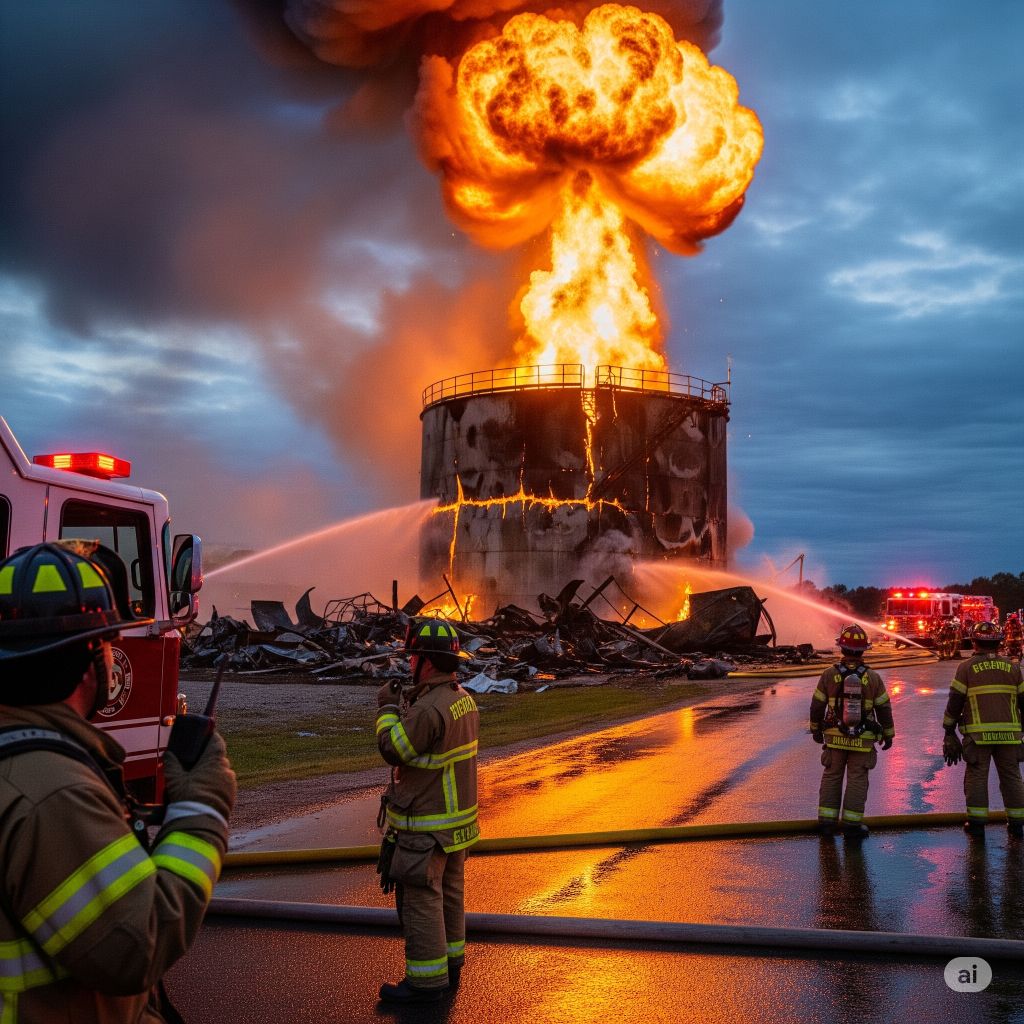
As someone who’s passionate about safety and preparedness, I’ve often come across the term BLEVE in discussions about hazardous materials and incidents. In this article, I’ll delve into what exactly a BLEVE is and why it’s crucial to understand its implications in various scenarios.
A BLEVE, which stands for Boiling Liquid Expanding Vapor Explosion, is a phenomenon that can occur when a pressurized vessel containing a liquid is suddenly ruptured, leading to a rapid release of vapor and potential explosion. Understanding the causes and consequences of a BLEVE is essential for first responders, emergency personnel, and anyone working with or near pressurized containers.
Join me as I break down the science behind BLEVEs, explore real-life examples, and discuss preventive measures that can help mitigate the risks associated with these dangerous events. Let’s equip ourselves with the knowledge needed to stay safe and informed in the face of potential emergencies.
Key Takeaways
- A BLEVE (Boiling Liquid Expanding Vapor Explosion) occurs when a pressurized vessel ruptures, releasing vapor and potentially leading to an explosion.
- Understanding the causes, consequences, and characteristics of a BLEVE is crucial for safety personnel and individuals near pressurized containers.
- The science behind BLEVEs involves rapid vaporization of liquid due to pressure drop, leading to a violent explosion with potential shrapnel projections.
- Causes of BLEVEs include sudden pressure release, exposure to heat sources, structural weakness, overfilling, and external fires.
- Real-life examples like the Los Alfaques Disaster and the Ghislenghien BLEVE highlight the destructive nature of BLEVE incidents.
- Preventive measures such as regular inspections, proper maintenance, employee training, emergency response plans, safety protocols, risk assessment, regulatory compliance, and continuous monitoring can help prevent BLEVE incidents and ensure safety.
What is a BLEVE?
A BLEVE, which stands for Boiling Liquid Expanding Vapor Explosion, is a serious phenomenon that can occur during hazardous materials incidents. It happens when a pressurized vessel holding a liquid suddenly ruptures, causing a rapid release of vapor and potentially leading to an explosion. This can pose significant risks to individuals in the vicinity, especially first responders and emergency personnel.
Understanding the characteristics of a BLEVE is crucial in managing such incidents effectively. The sudden release of vapor and potential explosion can result in wide-ranging consequences, from property damage to serious injuries or loss of life. Therefore, having a thorough grasp of what a BLEVE entails is essential for anyone working with or around pressurized containers.
In case of a BLEVE, the sudden release of a liquid’s vaporization pressure can cause a rapid expansion of the liquid-gas mixture. This increase in volume can lead to a significant increase in pressure, potentially resulting in a violent explosion. Recognizing the signs and dangers associated with a BLEVE is fundamental in responding promptly and implementing necessary safety measures to mitigate risks and ensure the well-being of everyone involved.
Science behind BLEVEs
Understanding the science behind BLEVEs is crucial in comprehending the potential dangers associated with these incidents. A BLEVE typically occurs when a pressurized vessel, like a propane tank, containing a liquid, such as liquefied petroleum gas, suddenly ruptures.
When the vessel ruptures, the liquid inside rapidly vaporizes due to the sudden drop in pressure, creating a large volume of pressurized vapor. This rapid vaporization generates immense heat and energy, which can lead to a violent explosion. The explosion can propel shrapnel and debris long distances, posing a significant risk to anything in the vicinity.
The intense pressure build-up within the vessel contributes to the force of the explosion, making BLEVEs particularly hazardous. This pressure can cause the vessel to fragment into sharp projectiles, further escalating the potential damage and injury risks.
Proper knowledge of the physics and mechanisms involved in a BLEVE is essential for prevention and mitigation strategies in hazardous materials incidents. By recognizing the warning signs and implementing safety protocols, responders can effectively manage BLEVE situations and minimize the impacts on both human lives and property.
Causes of BLEVEs
When it comes to understanding the causes of BLEVEs (Boiling Liquid Expanding Vapor Explosions), it’s crucial to delve into the key factors that contribute to these hazardous incidents. Here are some of the primary reasons why BLEVEs occur:
- Sudden Pressure Release: One of the main triggers for a BLEVE is the abrupt release of pressure within a pressurized vessel, leading to a rapid change in the state of the contained liquid.
- Exposure to Heat Sources: Exposure to high temperatures can cause the liquid inside the vessel to boil rapidly, creating a significant increase in vapor pressure that may exceed the vessel’s capacity.
- Structural Weakness: Weaknesses in the vessel’s structure, whether due to corrosion, physical damage, or other factors, can compromise its integrity and lead to a catastrophic failure.
- Overfilling: Filling a vessel beyond its recommended capacity can create excessive pressure build-up, increasing the risk of a BLEVE event.
- External Fires: In the event of a fire near a pressurized vessel, the heat generated can raise the temperature of the vessel, potentially causing the liquid inside to reach its boiling point and trigger a BLEVE.
By recognizing these underlying causes of BLEVEs, emergency responders and safety personnel can take proactive measures to prevent these incidents and mitigate their potential impacts. Stay tuned as we further explore strategies for managing BLEVE situations effectively.
Real-life examples of BLEVE incidents
In my years of experience, I’ve come across various real-life instances showcasing the destructive power of BLEVE incidents. These incidents serve as stark reminders of the importance of understanding and effectively managing such hazardous events. Here are a few notable examples:
- Los Alfaques Disaster (1978):
- Location: Spain
- Description: A tanker truck carrying 23 tons of liquefied propane crashed, leading to a massive explosion that killed over 200 people and injured numerous others.
- Catastrophic BLEVE in Mexico (1984):
- Location: San Juanico, Mexico
- Description: A pemex liquid petroleum gas tank exploded, resulting in a catastrophic fire that caused multiple fatalities, extensive injuries, and significant property damage.
- Ghislenghien BLEVE (2004):
- Location: Belgium
- Description: A gas pipeline rupture triggered a BLEVE at a storage facility, causing a massive explosion that claimed the lives of 24 individuals and injured many more.
These tragic events underscore the critical need for thorough risk assessment, robust safety protocols, and swift emergency response measures to mitigate the devastating consequences of BLEVE incidents. Stay informed, stay prepared.
Preventive measures for BLEVE incidents
When it comes to preventing Boiling Liquid Expanding Vapor Explosion (BLEVE) incidents, vigilance and preparedness are key. Here are some essential preventive measures to consider:
- Regular Inspections: I recommend conducting frequent inspections of all equipment and storage vessels to detect any signs of wear, corrosion, or structural weaknesses.
- Proper Maintenance: Ensuring proper maintenance of equipment, valves, and pressure relief systems is crucial in preventing potential BLEVE incidents.
- Employee Training: Providing comprehensive training to all personnel on handling hazardous materials, emergency response procedures, and recognizing early warning signs of potential BLEVE situations is essential.
- Emergency Response Plans: Developing and regularly practicing emergency response plans can help minimize the impact of a BLEVE incident and save lives.
- Safety Protocols: Implementing strict safety protocols such as proper ventilation, temperature monitoring, and pressure control measures can significantly reduce the risk of a BLEVE occurrence.
- Risk Assessment: Conducting a thorough risk assessment of the facility, processes, and equipment can help identify potential hazards and vulnerabilities that could lead to a BLEVE event.
- Regulatory Compliance: Ensuring compliance with all relevant safety regulations, standards, and guidelines is vital in maintaining a safe working environment and preventing BLEVE incidents.
- Continuous Monitoring: Implementing continuous monitoring of critical parameters such as temperature, pressure, and gas levels can help detect abnormalities and take corrective actions promptly.
Implementing these preventive measures can go a long way in reducing the likelihood of a BLEVE incident and ensuring the safety of personnel and the surrounding environment.
Conclusion
Implementing rigorous preventive measures is paramount in mitigating the risk of BLEVE incidents. Regular inspections, proper maintenance, employee training, emergency response plans, safety protocols, risk assessment, regulatory compliance, and continuous monitoring are all essential components in preventing these dangerous events. By prioritizing safety measures, we can safeguard both individuals and the environment from the devastating consequences of a BLEVE. Stay proactive, stay informed, and stay safe.
Frequently Asked Questions
What is the importance of preventive measures in avoiding BLEVE incidents?
Preventive measures are crucial in reducing the risk of BLEVE events. Regular inspections, maintenance, employee training, emergency plans, safety protocols, risk assessment, compliance, and monitoring help prevent accidents.
Why is regular inspection important in preventing BLEVE incidents?
Regular inspections help identify potential issues early, allowing for timely maintenance and repairs. This proactive approach helps prevent equipment failures that could lead to BLEVE incidents.
How does employee training help in avoiding BLEVE incidents?
Well-trained employees can recognize potential hazards, follow safety protocols, and respond effectively during emergencies, reducing the likelihood of BLEVE incidents.
Why is regulatory compliance essential for preventing BLEVE events?
Adhering to regulations ensures that safety standards are met, equipment is maintained properly, and necessary precautions are in place to prevent BLEVE incidents. Compliance measures help mitigate risks effectively.
Why is continuous monitoring critical in reducing the risk of BLEVE incidents?
Continuous monitoring allows for real-time assessment of equipment performance, environmental conditions, and potential hazards. This proactive monitoring helps detect issues early and prevent BLEVE events.
